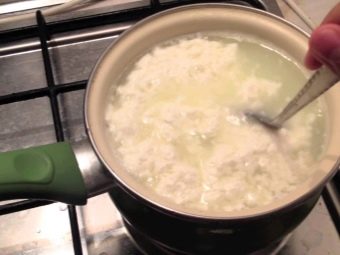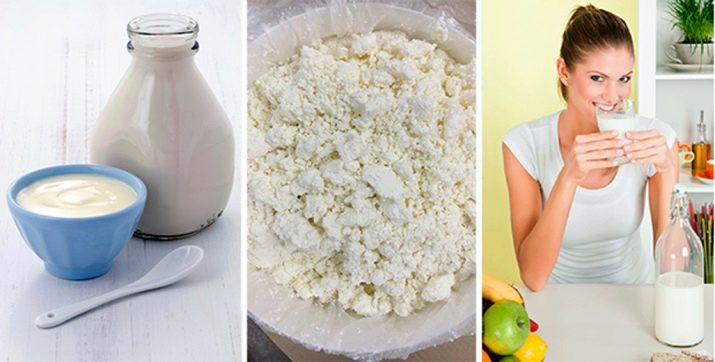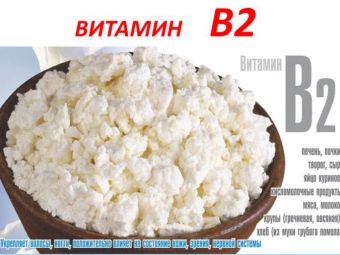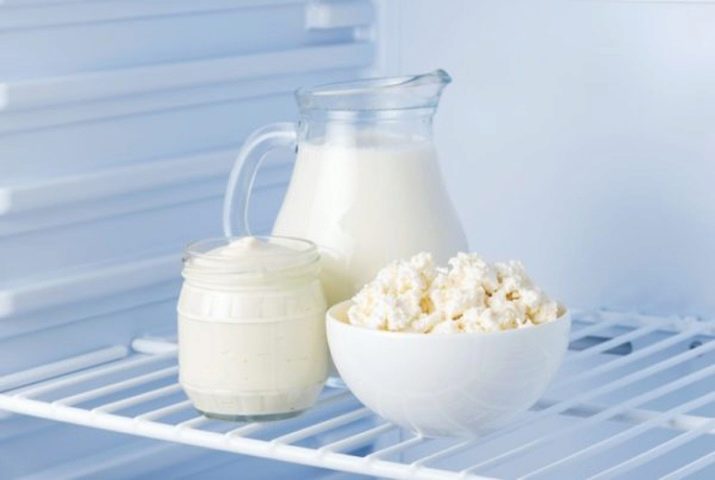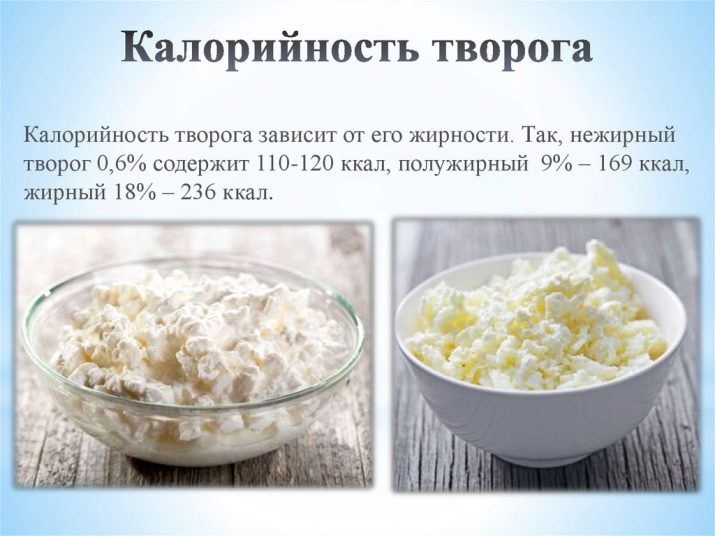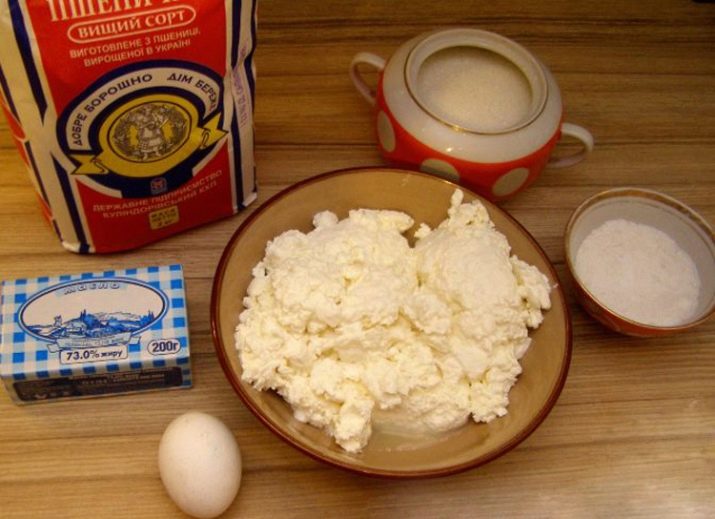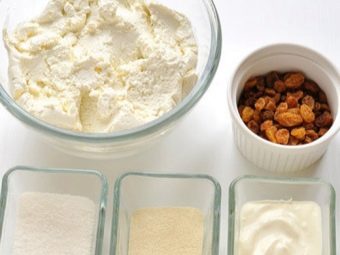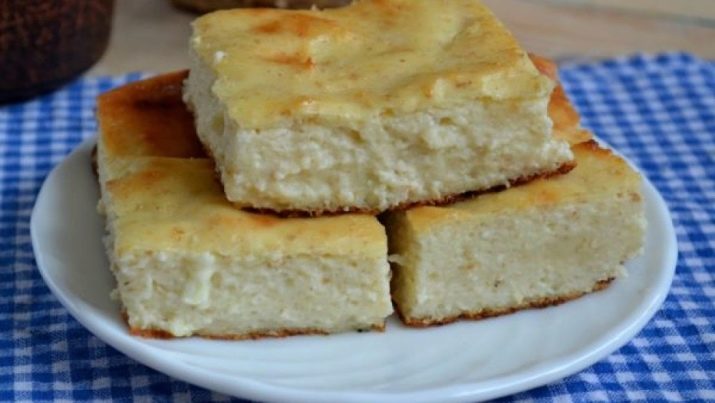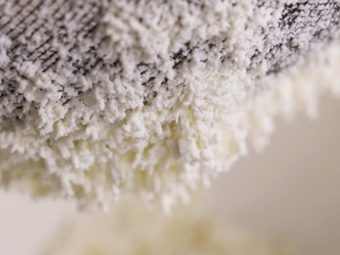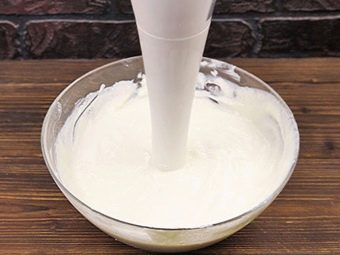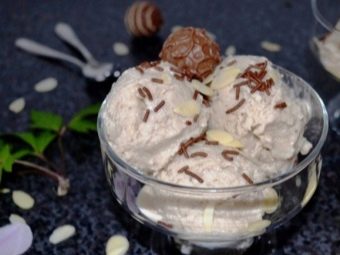The benefits, harm and composition of cottage cheese
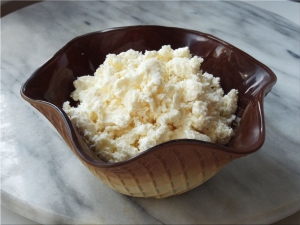
Cottage cheese a priori is considered a useful product.However, the way it is - only in rare cases, cottage cheese is contraindicated for healthy people. Or if you use it completely wrong, at the wrong time and in not so much. To avoid this, you just need to learn about the usefulness and harm of the product a little more than nothing.
What it is?
Cottage cheese is a fermented milk product obtained by souring milk. Then the whey is separated from the resulting mass, and the rest is cottage cheese.
The product is used by mankind for a long time, and already in the ancient world this was done for medicinal purposes. The first mention of a similar product is found in artifacts found in Mesopotamia, Ancient Rome. In Russia, cottage cheese was also a frequent dish on the table, although it was called cheese. Hence the name "cheesecakes" - a small baking based on cottage cheese.
Cottage cheese can be prepared using several technologies:
- classical;
- separate.
The first technology, in turn, is divided into two ways - acid and acid-rennet. In the first method, skimmed milk acts as a raw material for cottage cheese, in which lactic acid and ferments are added, thereby stimulating the fermentation process. In the case of the acid-rennet production method, rennet enzyme and lactic acid bacteria are placed in the milk.
With separate technology, milk is divided into 2 fractions - skim product and cream with a fat content of 55%. This is done by a separator. After that, rennet-acid ingredients are put into skimmed milk and the curd mass is obtained when heated. It remains only to cool it and complete the fermentation process by adding a certain amount of cream obtained in the first stage of the preparation of cottage cheese.
According to its consistency, cottage cheese is granular and pasty. According to the majority, the first one is good for consumption in its pure form, while the curd of a pasty consistency is convenient to use when cooking (as a filling for pies, baked pies, cheesecakes).
Beneficial features
Cottage cheese is a source of protein, an average of 14-18% protein per 100 g of product. Moreover, unlike the meat analogue, this protein breaks down into flakes and does not contain fibers, therefore, it is absorbed easier and faster.
Protein is a building material for muscles, tissues, enzymes, its deficiency provokes a violation of metabolic processes. It is extremely important to sufficient intake of protein in the body to build muscle mass, which is why cottage cheese is one of the main products in the diet of athletes, and is also useful for men engaged in heavy physical labor.
The product contains a lot of calcium, which is needed for the construction and strengthening of the skeletal system, tooth enamel. The need for cottage cheese is obvious, but there are periods in a person's life when the body experiences an increased need for calcium. This category includes women during pregnancy and lactation. Calcium entering the body is necessary for building the bones of a child. In this category are also children, adolescents, the elderly. It is logical that the amount of consumed curd can be increased after bone fractures.
Cottage cheese helps old people to protect themselves from osteoporosis, which is manifested by increased bone fragility. In addition, the product reduces cholesterol, strengthens the heart and blood vessels, improves cerebral circulation. All this is obvious reasons why cottage cheese should be included in the menu of elderly people.
Multicomponent fermented milk product, rich in phosphorus and calcium, is also extremely necessary for tuberculosis, anemia. For gout and similar diseases of the joints, it is recommended to reduce the consumption of meat. In this case, cottage cheese will be one of the alternative options for meat products.
In addition to the beneficial effects on the skeleton, calcium is involved in the process of blood formation, metabolic processes.The results of scientific studies prove that with the rapid saturation of the body with calcium (namely, this happens with the consumption of cottage cheese), it binds free radicals.
The latter are “broken” molecules with a missing electron. They attack healthy cells, causing malfunctions in their work. This, in turn, can cause the development of cancer. Thus, we can say that regular consumption of cottage cheese is one of the preventive measures in the fight against cancer.
Fat varieties of cottage cheese are characterized by high nutritional value, they give a feeling of saturation, enrich the body with the necessary mineral and vitamin set, but do not overload the digestive organs and excretion. This allows us to recommend a product for the nutrition of people who have undergone an operation or are at the stage of recovery after a serious illness.
Fermented milk product also It supports the health of the liver, protecting it from obesity. This is made possible by methionine, an essential amino acid found in cottage cheese. Obesity of the liver provoke the influence of toxins (including taking a number of drugs), elevated cholesterol.
That is why it is so important to include a sufficient amount of cottage cheese in the daily diet with antibiotic treatment.
Cottage cheese is rich in lactic acid bacteria, which normalize the intestinal microflora, improve digestion. Cottage cheese contributes to the destruction of pathogenic microflora and active reproduction useful, which is why it is useful for gastritis. Improving the state of consumption of cottage cheese brings with peptic ulcer, Crohn's disease, pancreatitis, colitis.
When indigestion, you should choose the types of product with low levels of fat content. Fatty foods in people with poor digestion can exacerbate unpleasant symptoms, nausea, and stool problems.
Enhancement of digestion also contribute to the enzymes present in the cheese. In addition, during the breakdown of protein and due to amino acids in the composition, with the consumption of cottage cheese, enzymes are also formed that improve the processes of food processing.
Potassium salts in the product have a slight diuretic effect, which allows us to recommend the product in the treatment of kidneys, hypertension. Potassium normalizes the water balance in the body, removing excess water. In combination with a low calorie content, this allows the use of the product for dietary nutrition. On the basis of cottage cheese there are diets and “fasting” days.
Vitamins B and protein can help maintain healthy skin, nails and hair. B vitamins in general have a beneficial effect on the skin, and protein acts as a building material for hair and skin cells, with a sufficient amount of it stimulates the production of the body's own collagen.
In addition, a large amount of vitamins B in the product allows it to normalize metabolic metabolism, a positive effect on the state of the nervous system. Folic acid (vitamin B9) in the product is needed for the formation of the internal organs of the fetus, therefore cottage cheese must be in the diet of women in the position.
These characteristics are more valid for the product from whole milk medium fat. Fat-free and too fatty counterparts, as well as products from baked or dried milk, have less beneficial properties and more contraindications.
Harm
Cottage cheese is contraindicated in case of individual intolerance to fermented milk products, casein. Fat homemade product should not be consumed by people overweight, atherosclerosis, and it is also harmful to the elderly. With age, fatty foods are absorbed worse, and in addition, it contains a lot of cholesterol, contributing to the "clogging" of blood vessels.
In addition, the content of rennet enzymes responsible for the processing of casein is reduced in adults in the intestines. As a result, it does not break down into amino acids, and the same form is sent to the lower intestine, causing fermentation, a feeling of swelling.It is clear that in this case, the cottage cheese becomes harmful to humans.
Fatty cottage cheese varieties are not recommended for atherosclerosis, liver and heart diseases. However, even in the absence of such health problems, this product should not be abused.
Excessive enthusiasm for protein foods will have a negative impact on the condition of the kidneys, and excessive calcium is also dangerous for health. In this way, one should not abuse cottage cheese and keep track of the total BJU of the daily diet, avoiding a "skew" in one direction or another (fat or protein).
Despite the positive effect of cottage cheese on the digestive tract organs in their severe pathologies, cottage cheese is in most cases prohibited. Until full recovery should abandon its consumption with intestinal infections. Similar recommendations are given for serious diseases of the liver and kidneys.
Cottage cheese for the child is a useful and necessary product, but it should be introduced into the diet not earlier than 5-7 months. A special product intended for baby food should be used. It should be introduced gradually, starting with the volume at the tip of a spoon and by the year increasing the amount of cottage cheese to 100-150 g per day.
You can not call fat cottage cheese harmful. On the contrary, in some cases, the person is recommended to eat just such a product. However, if you consider cottage cheese as the main source of calcium and phosphorus, give up the low-fat version or combine it with a classic product. The fact is that fat-soluble vitamins A and D in a low-fat product are contained in minimal amounts, and calcium and phosphorus are absorbed worse. For a nursing mother, cottage cheese can be useful, provided that there is no allergy in infants. In more detail about schemes of its use during lactation it will be discussed in the corresponding section of the article.
Speaking about the dangers of cottage cheese, it should be noted that benefit only fresh product. You can not take in food curd expired. If from this moment 1-2 days have passed, then it is permissible to make a casserole, pancakes or cheese cakes from such cottage cheese.
Store cottage cheese should be in the refrigerator. If you opened the package, then you should not keep the product in the package; you should put it in an enamel or glass container.
Nutritional value and composition
The composition of cottage cheese contains many components, the concentration of which is affected by the method of preparation and characteristics of the raw material of the product. About 65-70% of the composition is water, in which minerals and vitamins are dissolved.
Vitamins A and B (B-1, -2, -4, -5, -6, folic acid, vitamin PP), H, and provitamin beta-carotene, and minerals — calcium, phosphorus, magnesium, and iron — are present in the composition of cottage cheese. , potassium, sodium.
Protein of a product, as well as all "sour milk", is acquired better, than that which is available in milk. It contains non-replaceable and essential acids. Fats are saturated and monounsaturated fats, carbohydrates - galactose and lactose. Approximately 1% of the composition is ash. Finally, cottage cheese is rich in fermented milk bacteria.
The right cottage cheese should have only milk and sourdough in it. The presence of thickeners, preservatives and sugars - a reason to abandon the product, or at least not to use it constantly.
If such “chemistry” is not indicated in the composition, but the shelf life of the product exceeds 5 days, the manufacturer simply “forgot” to indicate it in the composition of the product. There is no doubt that it is present.
Glycemic Index and Calorie
Calorie curd depends on its fat content. So, the most fat and high-calorie is homemade cottage cheese, the fat content of which is from 18%. Opposite to it is low-fat cottage cheese, the fat content of which is up to 3%. Its type is a fat-free product with fat values up to 1.8%. "Intermediate" is cottage cheese with average fat content, it is also called soft and dietary - its fat content is from 9%.
BZHU of each type, respectively, varies somewhat. So, in home fatty curd fat contains more than in other forms.Their figure is at least equal to 18%, but the protein content is reduced to 15 g. The richest in protein is low-fat and low-fat foods, in which the amount of protein can reach 22 g, and the amount of fat is significantly reduced and equal to 0.6-1 g.
Knowing the features that affect the energy value of the product, you can consider the approximate caloric content of the product. So, fat cottage cheese with indicators of fat content of 18% contains 236 kcal. Do not forget that the amount of fat in the home product may increase, and with it, respectively, and caloric content. In 100 g of bold curd 9% contains 169 kcal, in the low-fat - 110-120 kcal, in the low-fat - up to 100 kcal.
Low-fat and bold curd can be calcined, that is, contain an increased amount of calcium. It does not affect the caloric indicators, however.
In addition, there are products with additives and fillers (jams, raisins, dried apricots). Of course, their energy value is higher than that of analogs without additives. The caloric content of such a product can increase due to the introduction of starches, stabilizers, which have to be added for such a combination, as well as for the storage of additives and dairy products.
Glycemic index of cottage cheese is low and is equal to 30 units. But its insulin index, like that of all protein products, is increased and amounts to 120 units. The difference between these values (although they are related) is colossal. The glycemic index (GI) is an indicator of the amount of sugar in the blood, which is detected when a product is consumed. Insulin (AI) is the amount of insulin required to process this product.
Consumption rules
In the absence of contraindications, an adult is allowed to eat up to 200-250 g of cottage cheese daily. Athletes, pregnant and lactating women can increase the dose to 300 g.
Nutritionists recommend alternating consumption of different varieties of cottage cheese. So, 3-4 times a week can be included in the diet fatty product. It will enrich the body with essential fatty acids, contains more vitamins, and calcium and phosphorus from such a cottage cheese are absorbed better. But with more frequent consumption of fat cottage cheese there is a chance of increasing the level of cholesterol in the blood, the appearance of excess weight.
Light curd can be consumed at almost any time of the year. In the morning a small amount of it (100 g) can supplement the porridge. Nutritionists insist that breakfast should be dense, contain large amounts of slow carbohydrates and some protein.
Carbohydrates charge porridge, and proteins - cottage cheese. You can serve it as a second breakfast, then you can increase the portion to 200-250 g and eat the product with strawberries, raspberries. But from the consumption of the product with berries and sweet fruits in the evening it is better to refuse - the meal will turn out too high in calories and rich in fast carbohydrates.
In the evening, you can eat a portion of cottage cheese with linseed oil or cook a casserole, syrniki. The main thing is that they do not contain a large amount of oil. To avoid this will help the grill pan or baking cheesecakes in the oven.
Cottage cheese will help out in the situation when there is no time or desire to take full hot food (this often happens in the heat of summer). In this case, add 1.5 cups of milk or kefir to the portion of the curd, banana and berries, and then beat the mass with a blender.
Such a cocktail will quench the feeling of hunger (its caloric content can reach 400-500 kcal), will delight you with excellent taste and will provide the body with the necessary amount of vitamins and microelements. To increase the caloric content of the drink can be added to it 1-2 tablespoons of oatmeal.
Cottage cheese is digested for quite a long time - about 1.5-3 hours, so you should not eat it at night. At the latest - 2-3 hours before bedtime.
For a woman who is breastfeeding, cottage cheese will become a source of protein and calcium, it will improve metabolic processes and contribute to an increase in lactation. The daily dosage of the product is 100-200 g, you can combine it with sour cream.It is better to have a classic, rather than a low-fat product. The optimal indicators of fat content of the product are within 5-9%. If the mother is overweight, it can be reduced to 3-5%.
Low-fat cottage cheese does not provide the woman's body with the right amount of calcium and vitamins, and too fat - will cause excess weight and violation of the stool in a child. Due to the presence of fats in the product, you should start to include cottage cheese in the diet not earlier than your baby will be 2-3 months old.
The appearance of problems with digestion in infants (stool disorders, flatulence, colic), as well as skin rash should be a reason to reduce the daily dosage of cottage cheese in the mom's diet. If this did not bring a crumbs of relief, it is worth while to give up cottage cheese.
Useful recipes
On the basis of cottage cheese, you can prepare a lot of healthy dishes and even a drink (we talked a little higher about a milkshake with cottage cheese). Consider the most interesting and useful ones.
These include cheesecakes - rich in proteins and calcium, nourishing and easy to prepare dish. You can fry them in a frying pan or bake in the oven. Served delicacy, sprinkled with powdered sugar and decorated with berries. Cheesecakes with sour cream are delicious.
For cooking it is better to take pasty curd of medium fat content. If only grain analog is at hand, it must first be rubbed through a sieve.
- 500 g of cottage cheese;
- 2-3 tablespoons of flour (for the PP version, you can substitute semolina, ground oatmeal, coconut or rice flour);
- 2-3 tablespoons of sugar or a substitute;
- 2 eggs.
In the cottage cheese you need to break the eggs, add sugar and mix the mixture thoroughly. Gradually introduce flour, ensuring that the dough remains tender and juicy. At the same time, it should not stick strongly to the hands and spread. The amount of flour given conditionally, you need to put as much as take the dough.
If you use coconut flour, remember that it dries the dough, so you need to put less. Rice flour, on the contrary, is in itself tender, thin, so it will need more. When adding flakes or semolina, you should pour a small amount of them into the dough, mix and leave for a quarter of an hour. During this time, the croup will swell and absorb some of the moisture. If necessary, you must again pour semolina or flakes and wait a bit again.
Pour flour over the work surface with a thin layer. From the dough to form small balls, then flatten them. It should turn out pellets 0.5-0.7 mm thick. They are breaded in flour (quite a bit, if there is a lot of breading, the curd cakes are hard) on both sides and fried in a hot frying pan in a small amount of butter. You can bake cheesecakes in the oven.
The dish can be cooked with raisins. 50 gr is enough for the specified number of ingredients. Raisins should be pre-filled with hot water and left for half an hour, then rinsed, dried with a towel.
So that it does not violate the structure of the dough, it is recommended to lightly (powder) flour with a flour before introducing the fruit.
Casserole
Many adults lovingly remember the casserole served in kindergarten. Indeed, the casserole is a tasty dish in which you can “hide” the curd, so not loved by many children.
Casserole is a versatile dish - it can be served for breakfast or dinner, replacing other dishes. If you serve it with fruit or berries, you get a wonderful dessert for tea or coffee.
For the casserole, you should also take a pasty consistency product, if there is none, rub the grain analogue through a sieve.
- 400 g of cottage cheese;
- 3-4 tablespoons of semolina;
- 2 eggs;
- half a cup sour cream medium fat (15%);
- 4-5 tablespoons of sugar;
- baking powder bag;
- vegetable oil for lubrication;
- vanilla, raisins - to taste.
If raisins are used, pre-soak it in hot water for 30 minutes. Connect semolina with sour cream, leave for a quarter of an hour, so that the croup swelled.
After a specified time, add cottage cheese to the mixture, salt (take a pinch to balance the taste of the dish, emphasize sweetness), baking powder. Thoroughly mix the composition, you can blender. It should be a homogeneous mass.
Slightly beat the eggs with sugar and gently add to the curd mass. Stir if raisin is used - enter it.
Grease the form (bottom and sides), pour in the dough and send it to the oven preheated to 180 ° C. Bake for 25-30 minutes, readiness to check with a toothpick. Remove the prepared casserole, cover with a clean towel and let cool. In the heat, cut the casserole and serve with sour cream.
A little tricks will help prepare the perfect casserole:
- you should not replace semolina flour, from this it will settle and the tenderness, airiness of the test will disappear;
- It is important to maintain a constant temperature throughout the baking process and try to open the oven as rarely as possible - the first 10-15 minutes of this should not be done exactly.
Cottage cheese cheesecake
Cheesecake is a traditional American cuisine dessert, which is a thin base on sand dough with a soft fill of soft cheese. The latter in this recipe is replaced by homemade curd.
The following ingredients are required for the cake:
- 100 g margarine or butter (pre-cool);
- 170 g of flour;
- 1 egg;
- 50 g of powdered sugar;
- a pinch of salt.
For cream fill (cream):
- 500 g homemade cottage cheese high fat;
- 100 ml of heavy cream (fat content not less than 35%);
- 5 eggs;
- 150 grams of sugar.
To prepare the cake, grate margarine or butter on a coarse grater, add powdered sugar, flour, and salt. Stir all, grinding flour with butter. Add the egg and remove the shortbread dough. Wrap it in a wrap and hold in the fridge for half an hour.
At this time, you can cook the cream. Curd mash through a sieve, break the eggs into a separate bowl, separating the whites from the yolks. Beating cottage cheese with a mixer, enter 4 yolks one by one. Add sugar and flour, the last - cream. Beat the mass again.
In a separate bowl, beat the squirrels (all 5 pieces) to the peaks and gently mix in the curd-yolk mass.
When the dough is cooled, thinly (0.4 cm thick) roll it and put it into shape, making the bottom and sides. Inside pour the cream. Bake 40 minutes at 170 degrees. Then reduce the intensity of the heat to 150 degrees and cook the cheesecake for another 20 minutes. When the dish is ready, it is not removed from the oven, but left for another hour, turning off the "stove" and leaving the door open.
Serve to the table, decorating with powdered sugar, jam, fruit, berries, chocolate chips.
With garlic and herbs
Cottage cheese can be the basis not only of sweet dishes and pastries, but also act as a snack. Prepared according to this recipe, the composition can be spread on sandwiches or, rolled up balls of it, add to vegetable salad.
- 450 g of cottage cheese;
- half a cup of sour cream;
- a bunch of parsley, dill, cilantro and green onions;
- salt, pepper - to taste;
- 4-5 cloves of garlic.
Curd mash through a sieve, chop the greens, push the garlic through a press. Combine all ingredients, mix well. Put in a bowl with a lid or form balls. The sharpness of the snack can be regulated by the amount of garlic and pepper. You can add chopped chili peppers.
Cilantro goes well with walnut. The kernel can be placed inside the curd ball.
Dessert with banana and honey
A great alternative to shopping sweets, the preparation of which requires neither great skill nor much time.
- 900 g of cottage cheese;
- 150 g of kefir;
- 3-4 tablespoons of honey;
- 2 tablespoons sour cream;
- 1 banana
Mix the ingredients and whip them with a blender. Distribute in plastic cups (6-7 cups are required for the specified number of products), cover with foil and send to the freezer.
When the mixture froze, it should be held for 1-2 hours in the refrigerator, and then served at the table.
Homemade candy
Delicate and juicy with creamy taste, curd sweets will help to cope with sweets and perfectly complement tea or coffee.The specified number of products is enough for 10-12 candies.
An important point - the dish can not be called low-calorie. An average of 100 g accounts for 210 kcal. But this option is a great way to feed the child with cottage cheese, if the child refuses to eat it in its purest form. In sweets, cottage cheese is not felt at all, only creamy tenderness remains.
- 200 g of cottage cheese;
- 3 teaspoons sour cream;
- 3 teaspoons powdered sugar;
- 1 teaspoon cocoa;
- a third of a bar of chocolate.
Combine cottage cheese with sour cream, it may take a little more or less. The mass should not be too liquid, sour cream at the same time should hold the curd particles together. Add to the mixture of cocoa and icing sugar, punch it with a blender until smooth.
From the resulting mass to form candy (for example, in the form of a ball), grate finely chocolate and roll candy in this chip. Send them in the fridge for 1-2 hours.
About how useful cottage cheese, see the following video.






